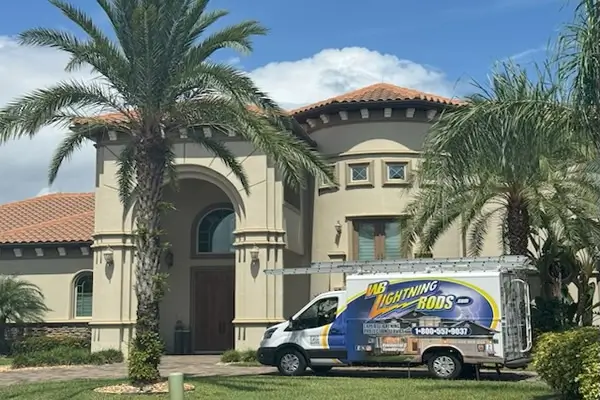Lightning is one of nature’s most powerful forces, capable of causing devastating fires, costly damage, and even endangering lives. Every year, thousands of structures across the United States are struck by lightning, resulting in billions of dollars in property loss. While many people assume only tall skyscrapers or industrial sites are at risk, the truth is that a wide variety of buildings benefit from professional lightning protection systems.
At WB Lightning Rods, we design and install custom lightning protection solutions that meet national safety standards, protecting property and lives. Below, we’ll explore the types of buildings that should strongly consider a lightning protection system.
Residential Homes
Your home is likely your largest investment—and it’s also vulnerable to lightning strikes. Homes with tall chimneys, metal roofs, or located on open lots and hilltops are at a higher risk. A single strike can damage electrical systems, destroy appliances, and even spark a fire in seconds.
Installing a lightning protection system with rods, conductors, and proper grounding helps direct lightning safely into the earth, preventing it from traveling through your home’s wiring or structure. For homeowners in regions with frequent thunderstorms, lightning protection is a smart way to safeguard both property and family.
Commercial Buildings
Businesses depend on uninterrupted operations. A lightning strike to a commercial property can result in costly downtime, equipment loss, and safety hazards for employees and customers.
Office buildings, retail centers, and restaurants often contain sensitive electronics, point-of-sale systems, and security devices—all highly susceptible to power surges caused by lightning. Protecting commercial buildings ensures that essential operations continue without disruption and reduces the risk of devastating losses.
Historic Buildings and Landmarks
Historic homes, churches, and museums hold irreplaceable value. Unfortunately, many of these structures were built long before modern electrical codes and may lack the necessary grounding to withstand a lightning strike. A single fire could erase centuries of history in minutes.
Lightning protection systems for historic properties are designed to be discreet, preserving the appearance of the building while providing state-of-the-art safety. Protecting these landmarks ensures that future generations can continue to enjoy them.
Agricultural Structures
Barns, silos, and other farm structures are particularly vulnerable to lightning because they are often isolated in open fields. Lightning can ignite stored hay, fuel, or chemicals, resulting in catastrophic losses. Additionally, strikes can injure or kill livestock sheltered in barns or stables.
Farmers who invest in lightning protection systems safeguard not only their buildings but also their valuable equipment and animals. Protecting agricultural operations helps prevent financial loss and ensures continuity in food production.
Industrial Facilities
Factories, warehouses, and manufacturing plants often store flammable materials and operate heavy machinery. A lightning strike could lead to fires, explosions, or production shutdowns. Industrial facilities also tend to be larger structures with expansive roofs, making them more prone to lightning strikes.
Proper lightning protection in these settings is not optional—it’s a critical safety measure. Many insurance companies and industry standards even recommend or require lightning protection for industrial sites.
Schools, Hospitals, and Public Buildings
Public institutions play a vital role in the community, making their safety a top priority. Schools and universities often have large campuses with athletic fields, tall buildings, and electronic equipment. Hospitals rely on continuous power to support life-saving equipment and cannot afford an unexpected outage.
Installing lightning protection systems in public buildings helps safeguard people and ensures essential services continue uninterrupted, even during severe weather.
Why Lightning Protection Matters
Any building exposed to open skies, valuable equipment, or human activity is a candidate for lightning protection. The National Fire Protection Association (NFPA) and Underwriters Laboratories (UL) both publish strict standards for lightning protection systems, ensuring safety and reliability when installed by qualified professionals.
At WB Lightning Rods, we specialize in custom-designed lightning protection systems for residential, commercial, historic, and agricultural properties. With decades of experience and a commitment to safety, we ensure your property is fully protected against nature’s most unpredictable force.
Protect Your Building Today
If you’re wondering whether your home, business, or facility needs lightning protection, the answer is likely yes. Don’t wait until after a costly strike to take action. Contact WB Lightning Rods today for a consultation and learn how our trusted solutions can keep your property safe.
Why WB Lightning Rods is Considered the Best Lightning Protection Contractor?
Protect your home or business from the devastating effects of lightning strikes—trust the experts at WB Lightning Rods. As a nationally recognized provider of commercial and residential lightning protection, WB Lightning Rods installs top-quality systems across the East Coast and Midwest and entire nation. With NFPA membership, full licensing and insurance, and a Five Star rating on Home Advisor, you can count on professional, reliable service. Don’t wait until it’s too late—contact WB Lightning Rods today to schedule your installation and ensure peace of mind, rain or shine.
We proudly offer comprehensive lightning protection services throughout the East Coast and beyond, including Arizona, Connecticut, Delaware, Florida, Georgia, Maine, Maryland, Massachusetts, New Hampshire, New Jersey, New York, North Carolina, Ohio, Pennsylvania, Rhode Island, South Carolina, and Virginia. With WB Lightning Protection, you’re not only getting superior service—you’re gaining peace of mind in every storm.



